Leptin's Role in Obesity and Genes in Parkinson's Disease: Biology
VerifiedAdded on 2022/12/29
|8
|2476
|32
Homework Assignment
AI Summary
This assignment solution delves into two key biological topics: the role of leptin in regulating appetite and its potential in treating childhood obesity, and the genes responsible for causing familial Parkinson's disease. The first section examines leptin's function as a hormone secreted by adipocytes, its impact on the hypothalamus, and its significance in controlling appetite and potentially treating obesity in children. The discussion highlights the interplay between leptin and insulin pathways, the involvement of various hormones in appetite regulation, and the use of leptin therapies. The second section focuses on Parkinson's disease, detailing its characteristics as a neurodegenerative disorder and the genetic factors contributing to its pathogenesis. It explores specific genes like SNCA, PARK2, PARK7, PINK1, and LRRK2, describing their roles and mutations associated with the disease, and their effects on molecular pathways.

online exam
Paraphrase This Document
Need a fresh take? Get an instant paraphrase of this document with our AI Paraphraser

Contents
MAIN BODY..................................................................................................................................1
Role of leptin in regulation of appetite and why it may be successful for treatment for a child
with severe on set obesity............................................................................................................1
Discuss genes responsible for causing familial Parkinson disease and its affect on molecular
pathways......................................................................................................................................3
REFERENCES................................................................................................................................6
MAIN BODY..................................................................................................................................1
Role of leptin in regulation of appetite and why it may be successful for treatment for a child
with severe on set obesity............................................................................................................1
Discuss genes responsible for causing familial Parkinson disease and its affect on molecular
pathways......................................................................................................................................3
REFERENCES................................................................................................................................6
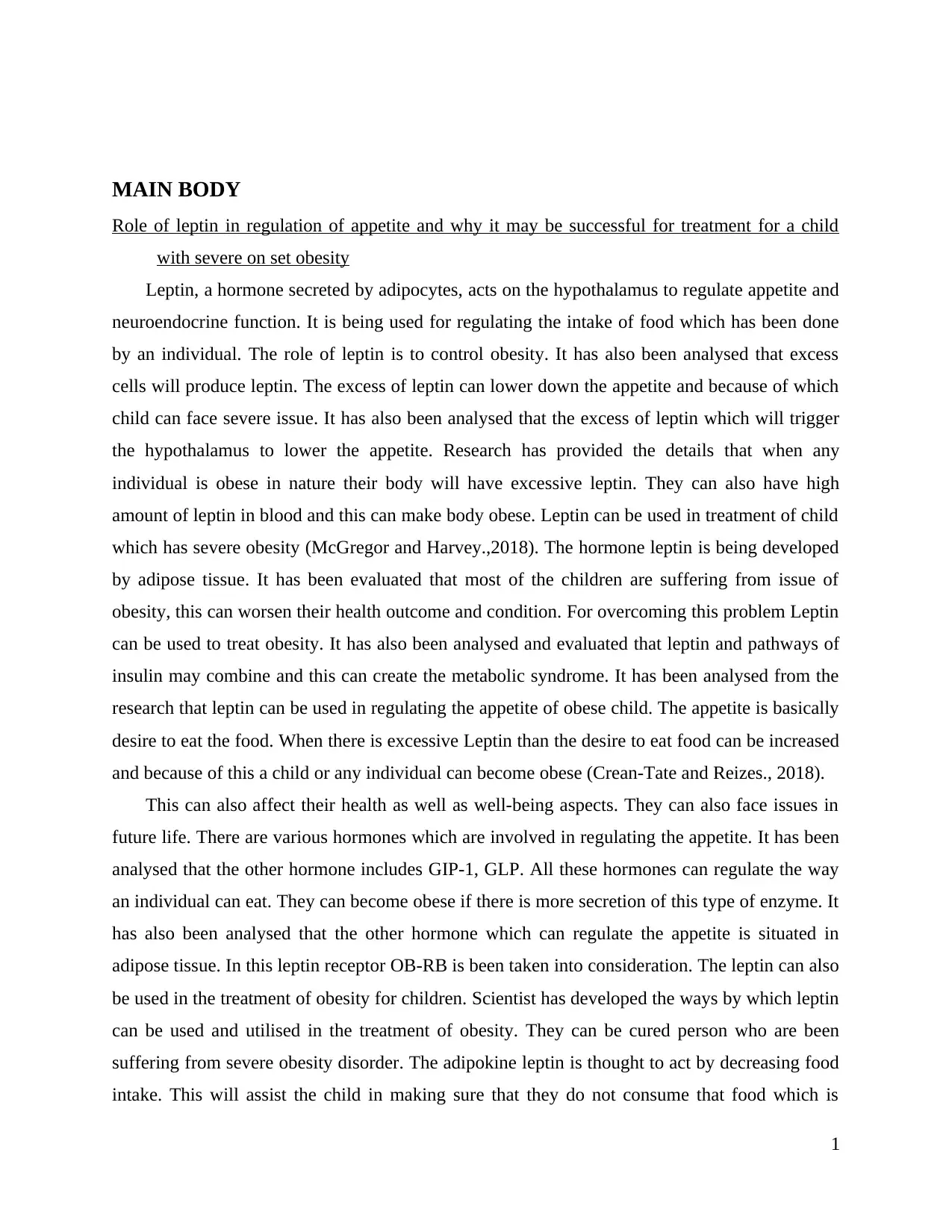
MAIN BODY
Role of leptin in regulation of appetite and why it may be successful for treatment for a child
with severe on set obesity
Leptin, a hormone secreted by adipocytes, acts on the hypothalamus to regulate appetite and
neuroendocrine function. It is being used for regulating the intake of food which has been done
by an individual. The role of leptin is to control obesity. It has also been analysed that excess
cells will produce leptin. The excess of leptin can lower down the appetite and because of which
child can face severe issue. It has also been analysed that the excess of leptin which will trigger
the hypothalamus to lower the appetite. Research has provided the details that when any
individual is obese in nature their body will have excessive leptin. They can also have high
amount of leptin in blood and this can make body obese. Leptin can be used in treatment of child
which has severe obesity (McGregor and Harvey.,2018). The hormone leptin is being developed
by adipose tissue. It has been evaluated that most of the children are suffering from issue of
obesity, this can worsen their health outcome and condition. For overcoming this problem Leptin
can be used to treat obesity. It has also been analysed and evaluated that leptin and pathways of
insulin may combine and this can create the metabolic syndrome. It has been analysed from the
research that leptin can be used in regulating the appetite of obese child. The appetite is basically
desire to eat the food. When there is excessive Leptin than the desire to eat food can be increased
and because of this a child or any individual can become obese (Crean-Tate and Reizes., 2018).
This can also affect their health as well as well-being aspects. They can also face issues in
future life. There are various hormones which are involved in regulating the appetite. It has been
analysed that the other hormone includes GIP-1, GLP. All these hormones can regulate the way
an individual can eat. They can become obese if there is more secretion of this type of enzyme. It
has also been analysed that the other hormone which can regulate the appetite is situated in
adipose tissue. In this leptin receptor OB-RB is been taken into consideration. The leptin can also
be used in the treatment of obesity for children. Scientist has developed the ways by which leptin
can be used and utilised in the treatment of obesity. They can be cured person who are been
suffering from severe obesity disorder. The adipokine leptin is thought to act by decreasing food
intake. This will assist the child in making sure that they do not consume that food which is
1
Role of leptin in regulation of appetite and why it may be successful for treatment for a child
with severe on set obesity
Leptin, a hormone secreted by adipocytes, acts on the hypothalamus to regulate appetite and
neuroendocrine function. It is being used for regulating the intake of food which has been done
by an individual. The role of leptin is to control obesity. It has also been analysed that excess
cells will produce leptin. The excess of leptin can lower down the appetite and because of which
child can face severe issue. It has also been analysed that the excess of leptin which will trigger
the hypothalamus to lower the appetite. Research has provided the details that when any
individual is obese in nature their body will have excessive leptin. They can also have high
amount of leptin in blood and this can make body obese. Leptin can be used in treatment of child
which has severe obesity (McGregor and Harvey.,2018). The hormone leptin is being developed
by adipose tissue. It has been evaluated that most of the children are suffering from issue of
obesity, this can worsen their health outcome and condition. For overcoming this problem Leptin
can be used to treat obesity. It has also been analysed and evaluated that leptin and pathways of
insulin may combine and this can create the metabolic syndrome. It has been analysed from the
research that leptin can be used in regulating the appetite of obese child. The appetite is basically
desire to eat the food. When there is excessive Leptin than the desire to eat food can be increased
and because of this a child or any individual can become obese (Crean-Tate and Reizes., 2018).
This can also affect their health as well as well-being aspects. They can also face issues in
future life. There are various hormones which are involved in regulating the appetite. It has been
analysed that the other hormone includes GIP-1, GLP. All these hormones can regulate the way
an individual can eat. They can become obese if there is more secretion of this type of enzyme. It
has also been analysed that the other hormone which can regulate the appetite is situated in
adipose tissue. In this leptin receptor OB-RB is been taken into consideration. The leptin can also
be used in the treatment of obesity for children. Scientist has developed the ways by which leptin
can be used and utilised in the treatment of obesity. They can be cured person who are been
suffering from severe obesity disorder. The adipokine leptin is thought to act by decreasing food
intake. This will assist the child in making sure that they do not consume that food which is
1
⊘ This is a preview!⊘
Do you want full access?
Subscribe today to unlock all pages.

Trusted by 1+ million students worldwide

unhealthy for them. This leptin regulator will assist in enhancing health outcome of that child
who is been suffering from obesity. This is being useful for children. In this research has
provided details that scientists have also developed the leptin therapies because of which obese
children do not face such type of issue. It has been analysed that the leptin resistance can be seen
in patients. It has also been evaluated that by going through this therapy there are various types
of other issues that has been faced by those patients who have gone through leptin treatment. For
patients who are been suffering from obesity there can be various other health related issues
which can be faced by them. The excessive body weight can lead to facing various types of
hormonal issues. It has been analysed that Leptin is the main hormone which is been related and
associated directly with the body weight. In this the appetite regulation can be increased if there
is an increased Leptin in the body. Children can become obese. This can affect their health
outcome severely and also because of this they can face severe issues in future. Their health and
well-being is affected when the child is obese. It can lower down their quality of life. For this
Leptin treatment can be given to child so that health outcome of them can be improved and also
excessive fat can be lower down by this. Leptin is sometimes called the satiety hormone. In this
hunger is been inhibited and also because of this the energy balance is been unregulated. It has
also been analysed that leptin has assisted in increasing the fats in body of an individual. This has
assisted in lowering down health outcome of patient. By this an individual cannot be able to
perform various tasks (Deem and et.al., 2018).
It has also been analysed that these treatments have failed because of the presence of high
circulating level of leptin. In this the resistance is been seen in most patients who are been
suffering from obesity. This treatment can also lead to lowering down of dietary intake and also
because of this they can be able to prevent further weight gain. By this they can also be able to
save themselves for the diseases. This treatment can be used in enhancing health outcome and
well-being of patients. Research has provided the details that when any individual is obese in
nature their body will have excessive leptin. They can also have high amount of leptin in blood
and this can make body obese (Odle., 2018). Leptin can be used in treatment of child which has
severe obesity. The latest research has provided details that Leptin is better for controlling the
appetite. This can be used for weight loss and also this can be used for enhancing metabolism of
patient. This can be used for treatment of child who are really obese. The leptin is being
produced naturally in body and it lets the brain know about the fats which are presented and
2
who is been suffering from obesity. This is being useful for children. In this research has
provided details that scientists have also developed the leptin therapies because of which obese
children do not face such type of issue. It has been analysed that the leptin resistance can be seen
in patients. It has also been evaluated that by going through this therapy there are various types
of other issues that has been faced by those patients who have gone through leptin treatment. For
patients who are been suffering from obesity there can be various other health related issues
which can be faced by them. The excessive body weight can lead to facing various types of
hormonal issues. It has been analysed that Leptin is the main hormone which is been related and
associated directly with the body weight. In this the appetite regulation can be increased if there
is an increased Leptin in the body. Children can become obese. This can affect their health
outcome severely and also because of this they can face severe issues in future. Their health and
well-being is affected when the child is obese. It can lower down their quality of life. For this
Leptin treatment can be given to child so that health outcome of them can be improved and also
excessive fat can be lower down by this. Leptin is sometimes called the satiety hormone. In this
hunger is been inhibited and also because of this the energy balance is been unregulated. It has
also been analysed that leptin has assisted in increasing the fats in body of an individual. This has
assisted in lowering down health outcome of patient. By this an individual cannot be able to
perform various tasks (Deem and et.al., 2018).
It has also been analysed that these treatments have failed because of the presence of high
circulating level of leptin. In this the resistance is been seen in most patients who are been
suffering from obesity. This treatment can also lead to lowering down of dietary intake and also
because of this they can be able to prevent further weight gain. By this they can also be able to
save themselves for the diseases. This treatment can be used in enhancing health outcome and
well-being of patients. Research has provided the details that when any individual is obese in
nature their body will have excessive leptin. They can also have high amount of leptin in blood
and this can make body obese (Odle., 2018). Leptin can be used in treatment of child which has
severe obesity. The latest research has provided details that Leptin is better for controlling the
appetite. This can be used for weight loss and also this can be used for enhancing metabolism of
patient. This can be used for treatment of child who are really obese. The leptin is being
produced naturally in body and it lets the brain know about the fats which are presented and
2
Paraphrase This Document
Need a fresh take? Get an instant paraphrase of this document with our AI Paraphraser
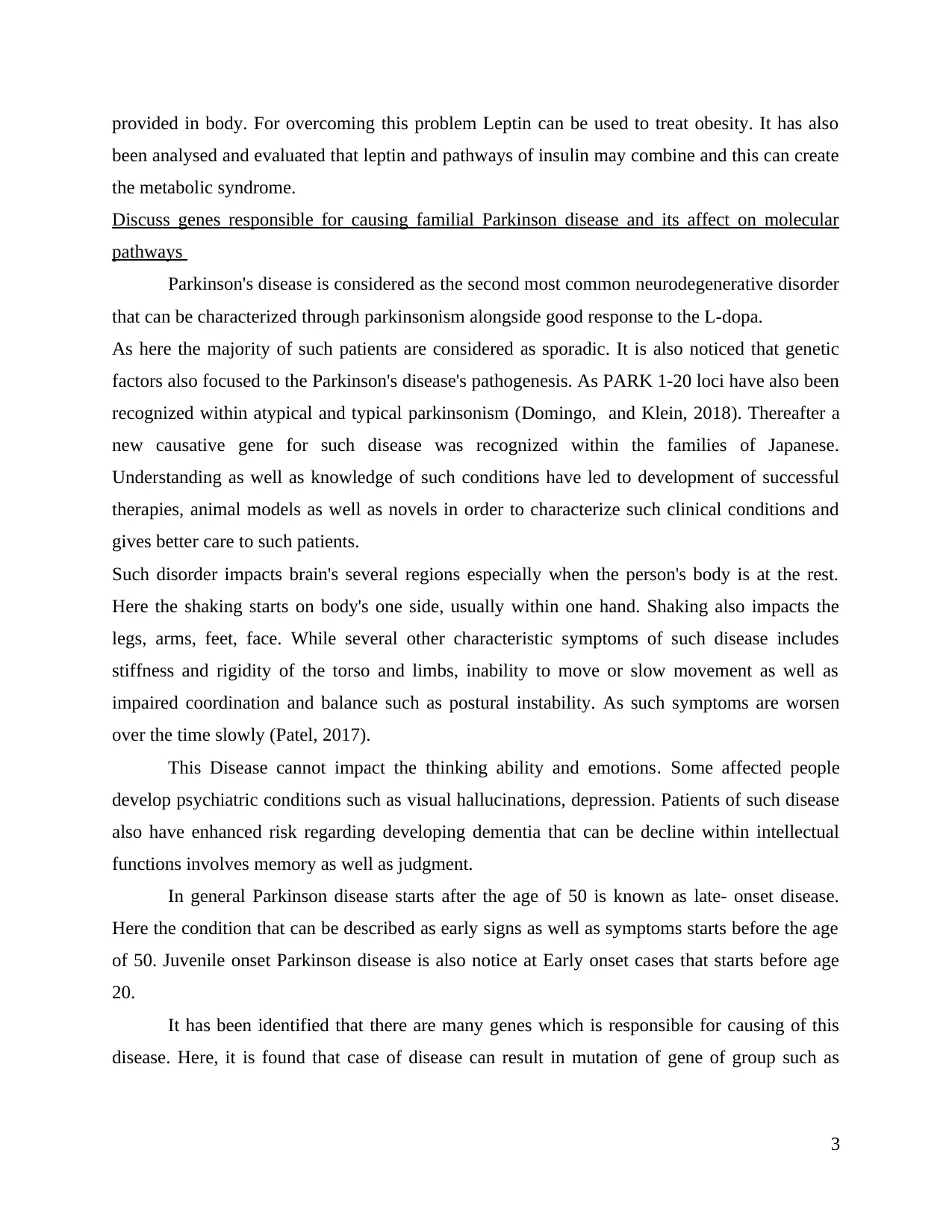
provided in body. For overcoming this problem Leptin can be used to treat obesity. It has also
been analysed and evaluated that leptin and pathways of insulin may combine and this can create
the metabolic syndrome.
Discuss genes responsible for causing familial Parkinson disease and its affect on molecular
pathways
Parkinson's disease is considered as the second most common neurodegenerative disorder
that can be characterized through parkinsonism alongside good response to the L-dopa.
As here the majority of such patients are considered as sporadic. It is also noticed that genetic
factors also focused to the Parkinson's disease's pathogenesis. As PARK 1-20 loci have also been
recognized within atypical and typical parkinsonism (Domingo, and Klein, 2018). Thereafter a
new causative gene for such disease was recognized within the families of Japanese.
Understanding as well as knowledge of such conditions have led to development of successful
therapies, animal models as well as novels in order to characterize such clinical conditions and
gives better care to such patients.
Such disorder impacts brain's several regions especially when the person's body is at the rest.
Here the shaking starts on body's one side, usually within one hand. Shaking also impacts the
legs, arms, feet, face. While several other characteristic symptoms of such disease includes
stiffness and rigidity of the torso and limbs, inability to move or slow movement as well as
impaired coordination and balance such as postural instability. As such symptoms are worsen
over the time slowly (Patel, 2017).
This Disease cannot impact the thinking ability and emotions. Some affected people
develop psychiatric conditions such as visual hallucinations, depression. Patients of such disease
also have enhanced risk regarding developing dementia that can be decline within intellectual
functions involves memory as well as judgment.
In general Parkinson disease starts after the age of 50 is known as late- onset disease.
Here the condition that can be described as early signs as well as symptoms starts before the age
of 50. Juvenile onset Parkinson disease is also notice at Early onset cases that starts before age
20.
It has been identified that there are many genes which is responsible for causing of this
disease. Here, it is found that case of disease can result in mutation of gene of group such as
3
been analysed and evaluated that leptin and pathways of insulin may combine and this can create
the metabolic syndrome.
Discuss genes responsible for causing familial Parkinson disease and its affect on molecular
pathways
Parkinson's disease is considered as the second most common neurodegenerative disorder
that can be characterized through parkinsonism alongside good response to the L-dopa.
As here the majority of such patients are considered as sporadic. It is also noticed that genetic
factors also focused to the Parkinson's disease's pathogenesis. As PARK 1-20 loci have also been
recognized within atypical and typical parkinsonism (Domingo, and Klein, 2018). Thereafter a
new causative gene for such disease was recognized within the families of Japanese.
Understanding as well as knowledge of such conditions have led to development of successful
therapies, animal models as well as novels in order to characterize such clinical conditions and
gives better care to such patients.
Such disorder impacts brain's several regions especially when the person's body is at the rest.
Here the shaking starts on body's one side, usually within one hand. Shaking also impacts the
legs, arms, feet, face. While several other characteristic symptoms of such disease includes
stiffness and rigidity of the torso and limbs, inability to move or slow movement as well as
impaired coordination and balance such as postural instability. As such symptoms are worsen
over the time slowly (Patel, 2017).
This Disease cannot impact the thinking ability and emotions. Some affected people
develop psychiatric conditions such as visual hallucinations, depression. Patients of such disease
also have enhanced risk regarding developing dementia that can be decline within intellectual
functions involves memory as well as judgment.
In general Parkinson disease starts after the age of 50 is known as late- onset disease.
Here the condition that can be described as early signs as well as symptoms starts before the age
of 50. Juvenile onset Parkinson disease is also notice at Early onset cases that starts before age
20.
It has been identified that there are many genes which is responsible for causing of this
disease. Here, it is found that case of disease can result in mutation of gene of group such as
3
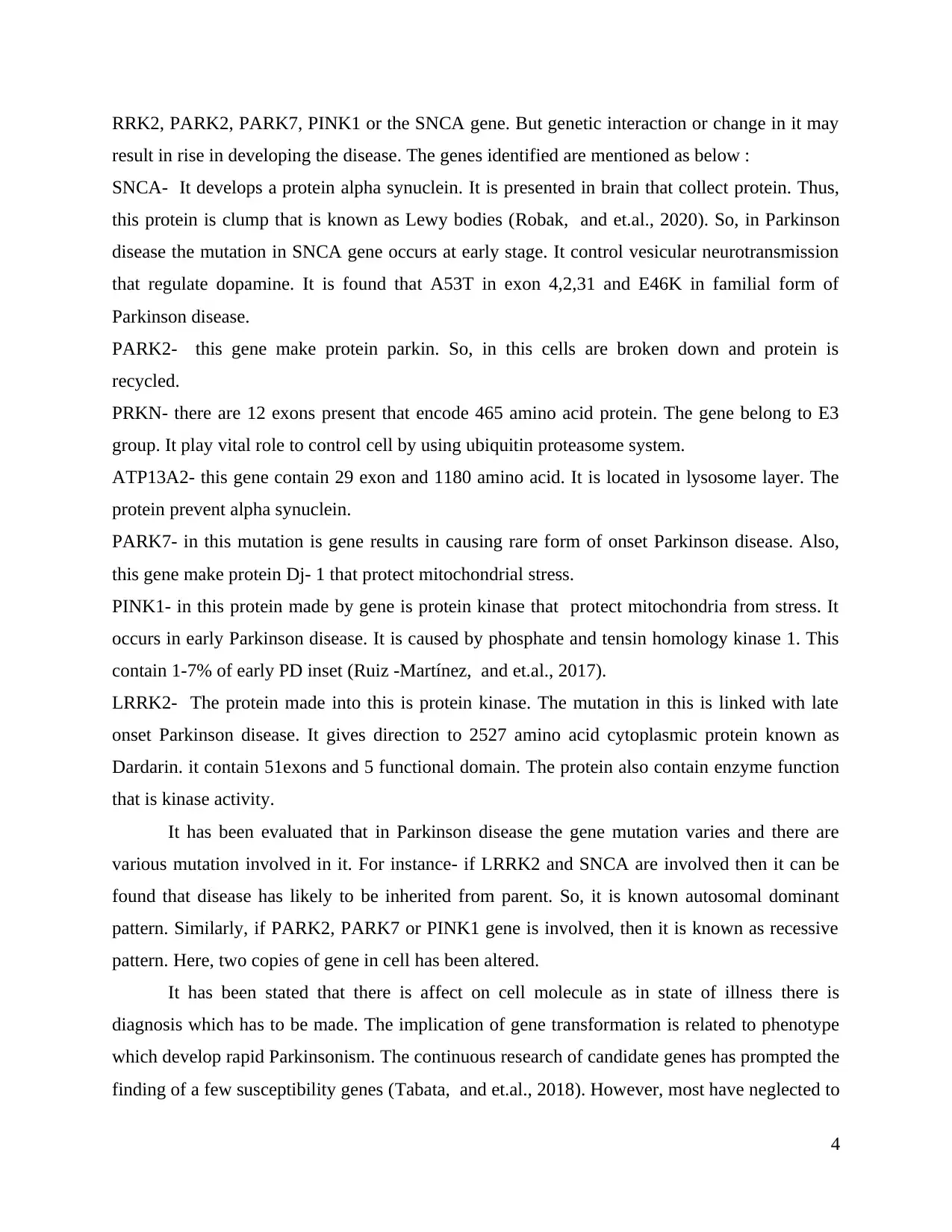
RRK2, PARK2, PARK7, PINK1 or the SNCA gene. But genetic interaction or change in it may
result in rise in developing the disease. The genes identified are mentioned as below :
SNCA- It develops a protein alpha synuclein. It is presented in brain that collect protein. Thus,
this protein is clump that is known as Lewy bodies (Robak, and et.al., 2020). So, in Parkinson
disease the mutation in SNCA gene occurs at early stage. It control vesicular neurotransmission
that regulate dopamine. It is found that A53T in exon 4,2,31 and E46K in familial form of
Parkinson disease.
PARK2- this gene make protein parkin. So, in this cells are broken down and protein is
recycled.
PRKN- there are 12 exons present that encode 465 amino acid protein. The gene belong to E3
group. It play vital role to control cell by using ubiquitin proteasome system.
ATP13A2- this gene contain 29 exon and 1180 amino acid. It is located in lysosome layer. The
protein prevent alpha synuclein.
PARK7- in this mutation is gene results in causing rare form of onset Parkinson disease. Also,
this gene make protein Dj- 1 that protect mitochondrial stress.
PINK1- in this protein made by gene is protein kinase that protect mitochondria from stress. It
occurs in early Parkinson disease. It is caused by phosphate and tensin homology kinase 1. This
contain 1-7% of early PD inset (Ruiz -Martínez, and et.al., 2017).
LRRK2- The protein made into this is protein kinase. The mutation in this is linked with late
onset Parkinson disease. It gives direction to 2527 amino acid cytoplasmic protein known as
Dardarin. it contain 51exons and 5 functional domain. The protein also contain enzyme function
that is kinase activity.
It has been evaluated that in Parkinson disease the gene mutation varies and there are
various mutation involved in it. For instance- if LRRK2 and SNCA are involved then it can be
found that disease has likely to be inherited from parent. So, it is known autosomal dominant
pattern. Similarly, if PARK2, PARK7 or PINK1 gene is involved, then it is known as recessive
pattern. Here, two copies of gene in cell has been altered.
It has been stated that there is affect on cell molecule as in state of illness there is
diagnosis which has to be made. The implication of gene transformation is related to phenotype
which develop rapid Parkinsonism. The continuous research of candidate genes has prompted the
finding of a few susceptibility genes (Tabata, and et.al., 2018). However, most have neglected to
4
result in rise in developing the disease. The genes identified are mentioned as below :
SNCA- It develops a protein alpha synuclein. It is presented in brain that collect protein. Thus,
this protein is clump that is known as Lewy bodies (Robak, and et.al., 2020). So, in Parkinson
disease the mutation in SNCA gene occurs at early stage. It control vesicular neurotransmission
that regulate dopamine. It is found that A53T in exon 4,2,31 and E46K in familial form of
Parkinson disease.
PARK2- this gene make protein parkin. So, in this cells are broken down and protein is
recycled.
PRKN- there are 12 exons present that encode 465 amino acid protein. The gene belong to E3
group. It play vital role to control cell by using ubiquitin proteasome system.
ATP13A2- this gene contain 29 exon and 1180 amino acid. It is located in lysosome layer. The
protein prevent alpha synuclein.
PARK7- in this mutation is gene results in causing rare form of onset Parkinson disease. Also,
this gene make protein Dj- 1 that protect mitochondrial stress.
PINK1- in this protein made by gene is protein kinase that protect mitochondria from stress. It
occurs in early Parkinson disease. It is caused by phosphate and tensin homology kinase 1. This
contain 1-7% of early PD inset (Ruiz -Martínez, and et.al., 2017).
LRRK2- The protein made into this is protein kinase. The mutation in this is linked with late
onset Parkinson disease. It gives direction to 2527 amino acid cytoplasmic protein known as
Dardarin. it contain 51exons and 5 functional domain. The protein also contain enzyme function
that is kinase activity.
It has been evaluated that in Parkinson disease the gene mutation varies and there are
various mutation involved in it. For instance- if LRRK2 and SNCA are involved then it can be
found that disease has likely to be inherited from parent. So, it is known autosomal dominant
pattern. Similarly, if PARK2, PARK7 or PINK1 gene is involved, then it is known as recessive
pattern. Here, two copies of gene in cell has been altered.
It has been stated that there is affect on cell molecule as in state of illness there is
diagnosis which has to be made. The implication of gene transformation is related to phenotype
which develop rapid Parkinsonism. The continuous research of candidate genes has prompted the
finding of a few susceptibility genes (Tabata, and et.al., 2018). However, most have neglected to
4
⊘ This is a preview!⊘
Do you want full access?
Subscribe today to unlock all pages.

Trusted by 1+ million students worldwide
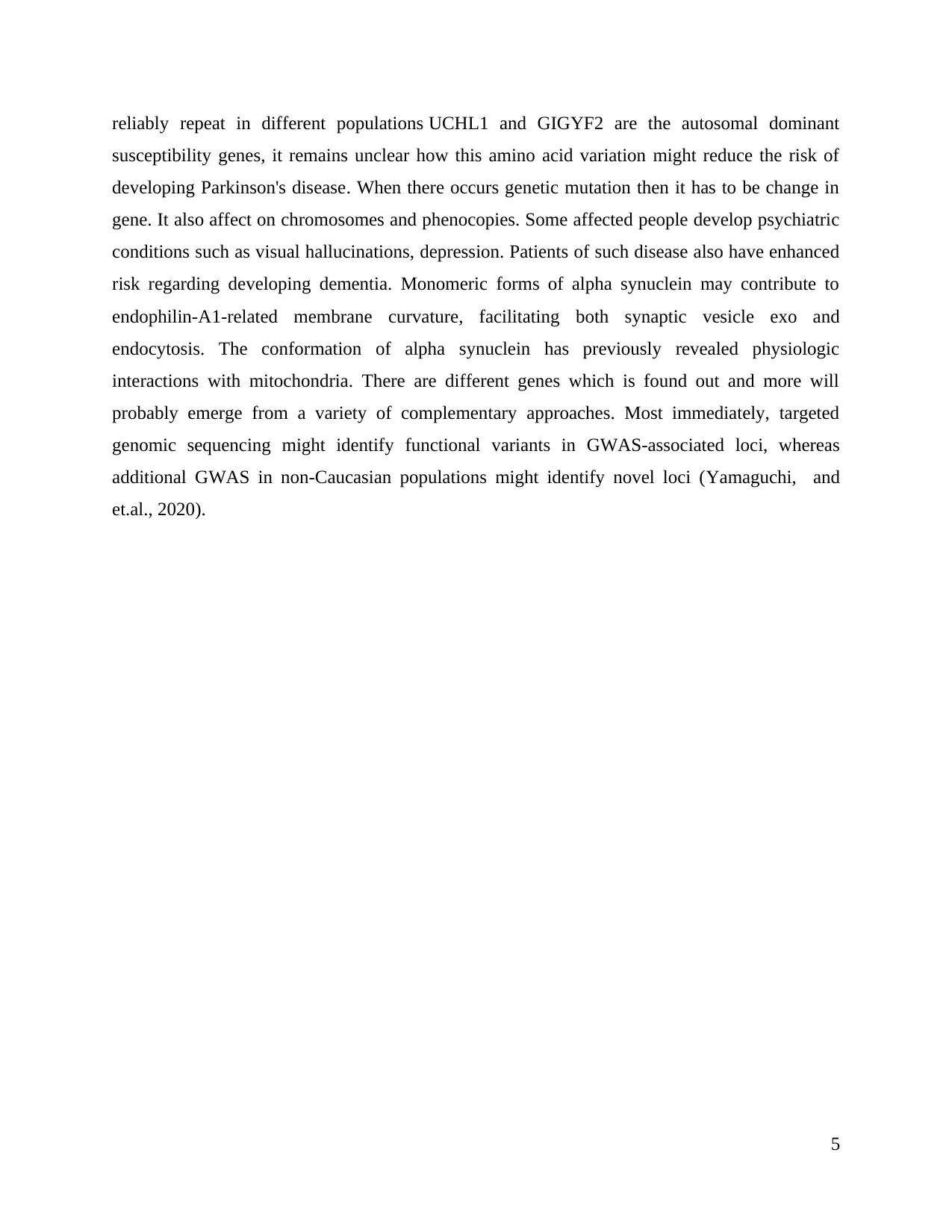
reliably repeat in different populations UCHL1 and GIGYF2 are the autosomal dominant
susceptibility genes, it remains unclear how this amino acid variation might reduce the risk of
developing Parkinson's disease. When there occurs genetic mutation then it has to be change in
gene. It also affect on chromosomes and phenocopies. Some affected people develop psychiatric
conditions such as visual hallucinations, depression. Patients of such disease also have enhanced
risk regarding developing dementia. Monomeric forms of alpha synuclein may contribute to
endophilin-A1-related membrane curvature, facilitating both synaptic vesicle exo and
endocytosis. The conformation of alpha synuclein has previously revealed physiologic
interactions with mitochondria. There are different genes which is found out and more will
probably emerge from a variety of complementary approaches. Most immediately, targeted
genomic sequencing might identify functional variants in GWAS-associated loci, whereas
additional GWAS in non-Caucasian populations might identify novel loci (Yamaguchi, and
et.al., 2020).
5
susceptibility genes, it remains unclear how this amino acid variation might reduce the risk of
developing Parkinson's disease. When there occurs genetic mutation then it has to be change in
gene. It also affect on chromosomes and phenocopies. Some affected people develop psychiatric
conditions such as visual hallucinations, depression. Patients of such disease also have enhanced
risk regarding developing dementia. Monomeric forms of alpha synuclein may contribute to
endophilin-A1-related membrane curvature, facilitating both synaptic vesicle exo and
endocytosis. The conformation of alpha synuclein has previously revealed physiologic
interactions with mitochondria. There are different genes which is found out and more will
probably emerge from a variety of complementary approaches. Most immediately, targeted
genomic sequencing might identify functional variants in GWAS-associated loci, whereas
additional GWAS in non-Caucasian populations might identify novel loci (Yamaguchi, and
et.al., 2020).
5
Paraphrase This Document
Need a fresh take? Get an instant paraphrase of this document with our AI Paraphraser
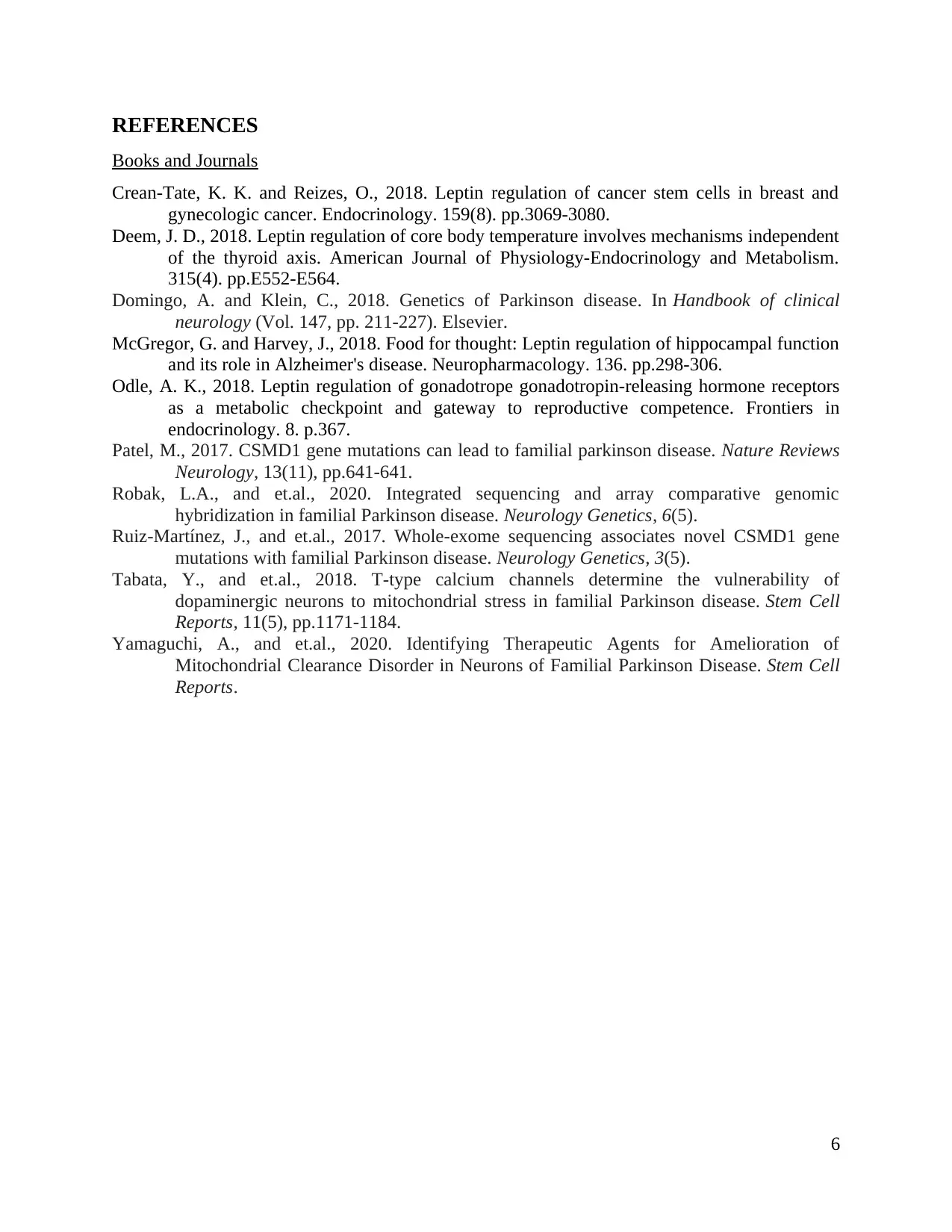
REFERENCES
Books and Journals
Crean-Tate, K. K. and Reizes, O., 2018. Leptin regulation of cancer stem cells in breast and
gynecologic cancer. Endocrinology. 159(8). pp.3069-3080.
Deem, J. D., 2018. Leptin regulation of core body temperature involves mechanisms independent
of the thyroid axis. American Journal of Physiology-Endocrinology and Metabolism.
315(4). pp.E552-E564.
Domingo, A. and Klein, C., 2018. Genetics of Parkinson disease. In Handbook of clinical
neurology (Vol. 147, pp. 211-227). Elsevier.
McGregor, G. and Harvey, J., 2018. Food for thought: Leptin regulation of hippocampal function
and its role in Alzheimer's disease. Neuropharmacology. 136. pp.298-306.
Odle, A. K., 2018. Leptin regulation of gonadotrope gonadotropin-releasing hormone receptors
as a metabolic checkpoint and gateway to reproductive competence. Frontiers in
endocrinology. 8. p.367.
Patel, M., 2017. CSMD1 gene mutations can lead to familial parkinson disease. Nature Reviews
Neurology, 13(11), pp.641-641.
Robak, L.A., and et.al., 2020. Integrated sequencing and array comparative genomic
hybridization in familial Parkinson disease. Neurology Genetics, 6(5).
Ruiz-Martínez, J., and et.al., 2017. Whole-exome sequencing associates novel CSMD1 gene
mutations with familial Parkinson disease. Neurology Genetics, 3(5).
Tabata, Y., and et.al., 2018. T-type calcium channels determine the vulnerability of
dopaminergic neurons to mitochondrial stress in familial Parkinson disease. Stem Cell
Reports, 11(5), pp.1171-1184.
Yamaguchi, A., and et.al., 2020. Identifying Therapeutic Agents for Amelioration of
Mitochondrial Clearance Disorder in Neurons of Familial Parkinson Disease. Stem Cell
Reports.
6
Books and Journals
Crean-Tate, K. K. and Reizes, O., 2018. Leptin regulation of cancer stem cells in breast and
gynecologic cancer. Endocrinology. 159(8). pp.3069-3080.
Deem, J. D., 2018. Leptin regulation of core body temperature involves mechanisms independent
of the thyroid axis. American Journal of Physiology-Endocrinology and Metabolism.
315(4). pp.E552-E564.
Domingo, A. and Klein, C., 2018. Genetics of Parkinson disease. In Handbook of clinical
neurology (Vol. 147, pp. 211-227). Elsevier.
McGregor, G. and Harvey, J., 2018. Food for thought: Leptin regulation of hippocampal function
and its role in Alzheimer's disease. Neuropharmacology. 136. pp.298-306.
Odle, A. K., 2018. Leptin regulation of gonadotrope gonadotropin-releasing hormone receptors
as a metabolic checkpoint and gateway to reproductive competence. Frontiers in
endocrinology. 8. p.367.
Patel, M., 2017. CSMD1 gene mutations can lead to familial parkinson disease. Nature Reviews
Neurology, 13(11), pp.641-641.
Robak, L.A., and et.al., 2020. Integrated sequencing and array comparative genomic
hybridization in familial Parkinson disease. Neurology Genetics, 6(5).
Ruiz-Martínez, J., and et.al., 2017. Whole-exome sequencing associates novel CSMD1 gene
mutations with familial Parkinson disease. Neurology Genetics, 3(5).
Tabata, Y., and et.al., 2018. T-type calcium channels determine the vulnerability of
dopaminergic neurons to mitochondrial stress in familial Parkinson disease. Stem Cell
Reports, 11(5), pp.1171-1184.
Yamaguchi, A., and et.al., 2020. Identifying Therapeutic Agents for Amelioration of
Mitochondrial Clearance Disorder in Neurons of Familial Parkinson Disease. Stem Cell
Reports.
6
1 out of 8
Related Documents
Your All-in-One AI-Powered Toolkit for Academic Success.
+13062052269
info@desklib.com
Available 24*7 on WhatsApp / Email
![[object Object]](/_next/static/media/star-bottom.7253800d.svg)
Unlock your academic potential
Copyright © 2020–2025 A2Z Services. All Rights Reserved. Developed and managed by ZUCOL.





